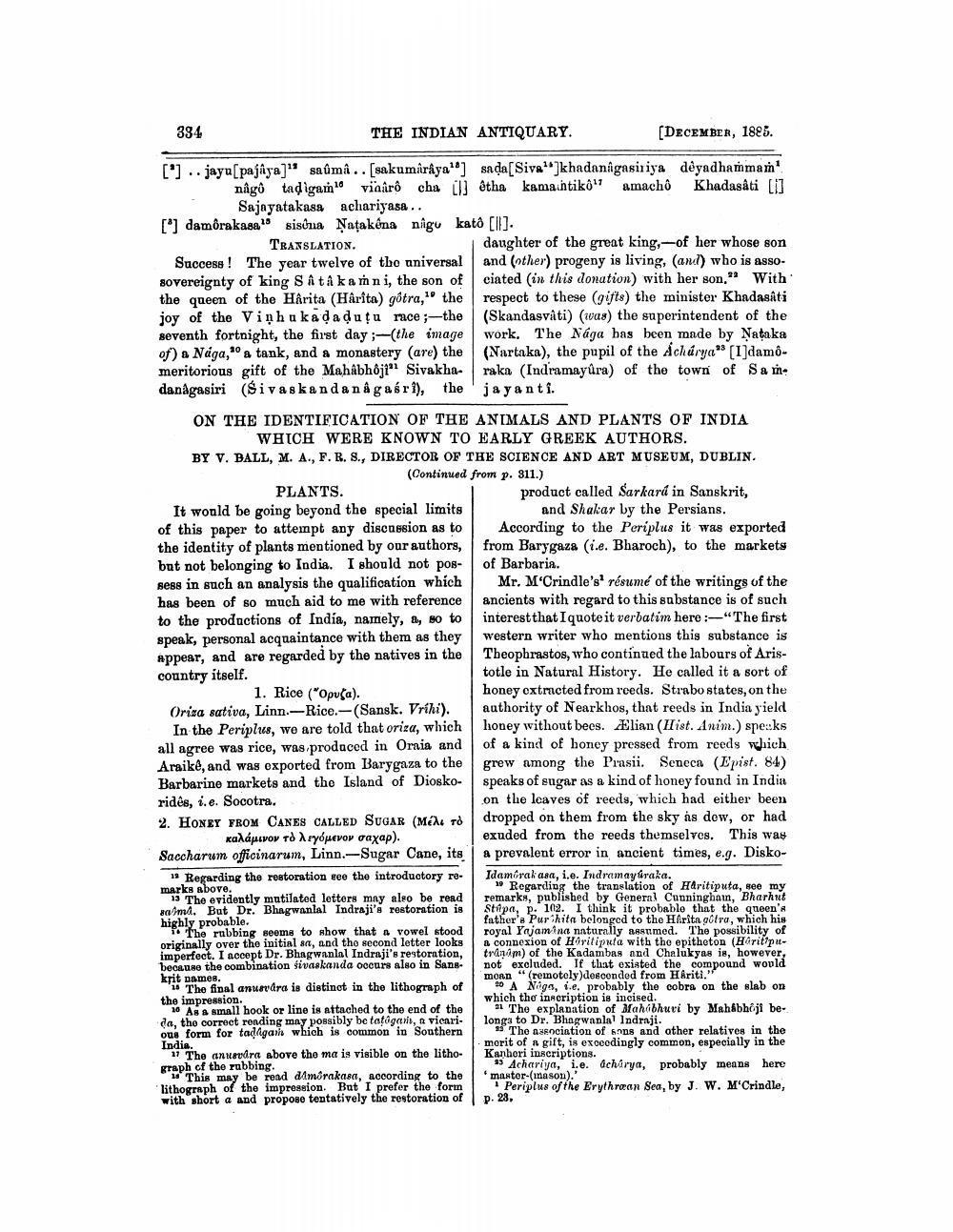________________
334
[DECEMBER, 1895.
16
[*] damôrakasa
[*].. jayu [pajaya]" saûmâ.. [sakumaraya"] sada[Siva"]khadanagasiriya deyadhammam någô taḍigam vinarô cha lêtha kamantikô1 amacho Khadasâti [] Sajayatakasa achariyasa.. sisûna Natakéna nagu TRANSLATION. Success! The year twelve of the universal sovereignty of king SAtakamni, the son of the queen of the Hârita (Hârîta) gotra, the joy of the Vinhukadaḍutu race; the seventh fortnight, the first day;-(the image of) a Núga, a tank, and a monastery (are) the meritorious gift of the Mahabhôj Sivakha danagasiri (Sivas kandanâgasri), the
20
THE INDIAN ANTIQUARY.
katô [].
daughter of the great king,-of her whose son and (other) progeny is living, (and) who is associated (in this donation) with her son." With respect to these (gifts) the minister Khadasâti (Skandasvâti) (was) the superintendent of the work. The Nága has been made by Nataka (Nartaka), the pupil of the Acharya" [I]damôraka (Indramayûra) of the town of Sam jayanti.
ON THE IDENTIFICATION OF THE ANIMALS AND PLANTS OF INDIA WHICH WERE KNOWN TO EARLY GREEK AUTHORS.
BY V. BALL, M. A., F. R. S., DIRECTOR OF THE SCIENCE AND ART MUSEUM, DUBLIN. (Continued from p. 311.)
PLANTS.
It would be going beyond the special limits of this paper to attempt any discussion as to the identity of plants mentioned by our authors, but not belonging to India. I should not possess in such an analysis the qualification which has been of so much aid to me with reference to the productions of India, namely, a, so to speak, personal acquaintance with them as they appear, and are regarded by the natives in the country itself.
1. Rice ("Opuga). Oriza sativa, Linn.-Rice.-(Sansk. Vrihi). In the Periplus, we are told that oriza, which all agree was rice, was produced in Oraia and Araike, and was exported from Barygaza to the Barbarine markets and the Island of Dioskoridês, i. e. Socotra.
2. HONEY FROM CANES CALLED SUGAR (MEA Tò καλάμινον τὸ λεγόμενον σαχαρ). Saccharum officinarum, Linn.-Sugar Cane, its
12 Regarding the restoration see the introductory remarks above.
13 The evidently mutilated letters may also be read sama. But Dr. Bhagwanlal Indraji's restoration is highly probable.
The rubbing seems to show that a vowel stood originally over the initial sa, and the second letter looks imperfect. I accept Dr. Bhagwanlal Indraji's restoration, because the combination sivaskanda occurs also in Sanskrit names.
The final anusvára is distinct in the lithograph of the impression.
10 As a small hook or line is attached to the end of the da, the correct reading may possibly be tatagan, a vicarious form for tadigan which is common in Southern
India.
17 The anusvára above the ma is visible on the lithograph of the rubbing.
This may be read dimorakasa, according to the lithograph of the impression. But I prefer the form with short a and propose tentatively the restoration of
product called Sarkara in Sanskrit, and Shakar by the Persians. According to the Periplus it was exported from Barygaza (i.e. Bharoch), to the markets of Barbaria.
Mr. M'Crindle's résumé of the writings of the ancients with regard to this substance is of such interest that I quote it verbatim here:-"The first western writer who mentions this substance is Theophrastos, who continued the labours of Aristotle in Natural History. He called it a sort of honey extracted from reeds. Strabo states, on the authority of Nearkhos, that reeds in India yield honey without bees. Elian (Hist. Anim.) speaks of a kind of honey pressed from reeds which grew among the Prasii. Seneca (Epist. 84) speaks of sugar as a kind of honey found in India on the leaves of reeds, which had either been dropped on them from the sky as dew, or had exuded from the reeds themselves. This was a prevalent error in ancient times, e.g. Disko
Idamorak asa, i.e. Indramayuraka.
19 Regarding the translation of Haritiputa, see my remarks, published by General Cunningham, Bharhut Stupa, p. 102. I think it probable that the queen's father's Pur hita belonged to the Harita gotra, which his royal Yajamana naturally assumed. The possibility of a connexion of Horitiputa with the epitheton (Hirit'putranam) of the Kadambas and Chalukyas is, however, not excluded. If that existed the compound would moan "(remotely)descended from Hariti.'
20 A Naga, i.e. probably the cobra on the slab on which the inscription is incised.
The explanation of Mahabhuvi by Mahabhōji belongs to Dr. Bhagwanlal Indraji.
The association of sons and other relatives in the merit of a gift, is exceedingly common, especially in the Kanheri inscriptions.
3 Achariya, i.e. acharya, probably means here master-(mason)."
Periplus of the Erythraan Sea, by J. W. M'Crindle,
p. 23,




